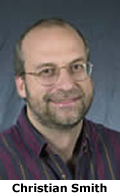
In 1997 and 1999, Christian Smith taught three-week summer seminars at Notre Dame, living on campus with his wife and kids.
But fond memories aren’t the only reason he feels at home under the Dome.
“I found Notre Dame attractive insofar as it has a theological, moral identity,” says Smith, a noted sociologist of religion who joined the University’s faculty last fall. “It’s a Catholic institution, and it’s trying to figure out what that means in a serious way.”
Along with that comes a commitment of University resources to further the study of religion. He says tangible support for initiatives like the Center for the Study of Religion and Society, which he directs, has Notre Dame poised “to do great stuff.”
And while such work is of obvious interest at a Catholic university, Smith — who himself isn’t Catholic — believes it also provides a powerful tool to examine how different communities, traditions and societies understand themselves and each other.
“Religion seems to meet people’s needs in a way that science, democracy and capitalism don’t,” he says, “so that even in a very highly modern world, religion seems to survive and sometimes thrive.”
Prior to coming to Notre Dame as William R. Kenan Jr. Professor of Sociology, Smith held an endowed chair at the University of North Carolina. He is the author, co-author or editor of numerous books, most recently the award-winning “Soul Searching: The Religious and Spiritual Lives of American Teenagers,” published by Oxford University Press.
“Soul Searching,” which Smith wrote with one of his doctoral students at North Carolina,__is based on the National Study of Youth and Religion (NSYR), an ongoing project he directs and that has been funded by the Lilly Endowment Inc. He says that there had not been much sociological research previously devoted to the religion of teenagers and, through conversations with his wife, he came to believe that studying them would provide a window into our broader society and culture.
Plus, with his own kids being preteen at the time, Smith thought reading up on teenagers might not be a bad idea.
What he’s found is that U.S. teens aren’t nearly as rebellious as he expected but instead “a barometer of the larger world around them.” And while on the surface they’re much more religious than he thought they would be — with religious kids tending to do better in school, have healthier relationships with others and exhibit more positive self-images — Smith says teens are often surprisingly uninformed and inarticulate about their faiths.
“I make this claim in the book that the actual, functional, tacit religion of the vast majority of American teenagers is not Baptist or Jewish or Catholic or whatever; it’s what I call Moralistic Therapeutic Deism,” he says.
Smith describes this faith as inter-religious. There’s a God who created the world and wants people to treat each other well but stays at a distance until asked to solve problems. The purpose of life is to be happy, and good people go to heaven.
“For many teens, God is something like a combination divine butler and cosmic therapist,” Smith says, “who comes when called, helps you to feel better, but doesn’t get too personally involved.”
In addition to the NSYR — for which he recently received major grants from Lilly and the John Templeton Foundation in support of a third wave of data collection — Smith is also leading the Multiple Modernities project.
This project is part of a growing movement questioning theories of modernization predominant in the 20th century. Smith explains that a basic idea behind the theories was that factors like advancing technology would inevitably corrode traditional cultural institutions, leading all societies to look the same eventually.
However, citing the experiences of countries like Japan — which has retained a distinct, non-Western identity even after its economy emerged as a global power — some scholars have started to advocate an alternative view of the modern world.
“Modernity in western Europe has turned out one way, but maybe modernity in Pakistan or Nigeria will turn out another way.” Smith says. “The idea is simply that the world might become modern and yet look quite different in quite different places. If so, sociology needs to come to grips with that.”
Smith’s project is mainly concerned with developing the idea of “multiple modernities” as it relates to religion, which the old theories believe will become secularized and perhaps disappear. Notre Dame, the preeminent Catholic university in one of the world’s most modern countries, seems a fitting place to undertake the investigation of alternative possible outcomes.
“In the end,” Smith says, “everybody is part of something particular, a tradition. One question is: `How good is that tradition at knowing what it is itself and engaging others constructively?’”
Originally published by at newsinfo.nd.edu on February 21, 2007.